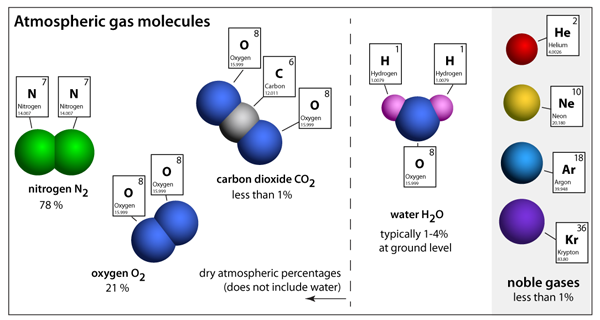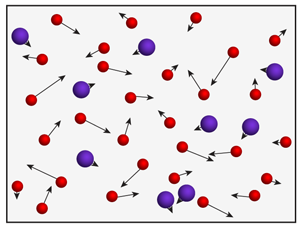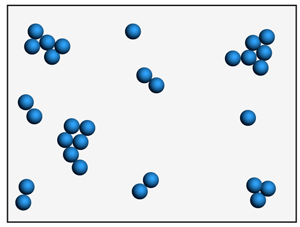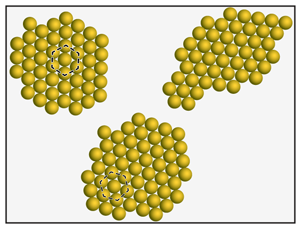All Matter is Made of Atoms
"If, in some cataclysm, all of scientific knowledge were to be destroyed, and only one sentence passed on to the next generations of creatures, what statement would contain the most information in the fewest words? I believe it is the atomic hypothesis (or the atomic fact, or whatever you wish to call it) that all things are made of atoms — little particles that move around in perpetual motion, attracting each other when they are a little distance apart, but repelling upon being squeezed into one another. In that one sentence, you will see, there is an enormous amount of information about the world, if just a little imagination and thinking are applied."
How big is an atom?
Atoms are very, very small. Atoms are so small that it is often said that there are as many atoms in a single grain of sand as there are grains of sand on all of the world's beaches — certainly a difficult thing to prove, but you get the idea — atoms are really small. Richard Feynman was a great scientist, and he once said that "another way to remember their size is this — if an apple is magnified to the size of the earth, then the atoms in the apple are approximately the size of the original apple."
From Apples to Atoms. An ordinary apple would need to be magnified 100 million times before you could see an atom! In each of the above panels the images are zoomed from an apple to a lady bug, then to pollen and eventually to individual atoms. The atoms are not clearly visible until the highest magnifications.
Apples, apple seeds, and ladybugs are easily measured and described by lengths that are millimeters (mm). But the thickness of the ladybug's antenna, the fine hairs on the antenna, and pollen are all best described by micrometers (µm) — a micrometer is 1,000 times smaller than a millimeter. Amazingly, even the sharp points on the microscopic pollen particles are still rough at the nanoscale; a nanometer is a thousand times smaller than a micrometer, or a million times smaller than a millimeter. Only at the highest magnifications are atoms observable. Atoms are only fractions of a nanometer (1/10 of a nanometer is an Angstrom, and atoms are only 1–2 Angstroms in size).
Everything is made of atoms!
Solids, liquids, and gases are all made of atoms, and there are lots of different types of atoms called elements. Each element has a unique mass and is given a specific atomic number; they are all arranged in the Periodic Table of the Elements.

The Periodic Table. Elements are numbered according to their mass, and they are grouped top to bottom and left to right based on similar attributes and behaviors. On the far right of the Periodic Table is a group of atoms called the noble gases.
In this simulation we explore the motions and atomistic interactions between helium (2He), neon (10Ne), argon (18Ar), and krypton (36Kr). These special atoms are the most common of the noble gases. They are called "noble" because they don't usually bond with other atoms to make molecules, and because they are all gases at room temperature we call them "the noble gases".
The air that we breathe is a gas and is primarily made of molecules. You have probably heard of most of them: "oxygen" (O2) is actually a molecule made of two oxygen atoms, "nitrogen" (N2) is a molecule made of two nitrogen atoms, and carbon dioxide (CO2) is a molecule that is made of one carbon atom and two oxygen atoms. There are very few noble gas atoms in our air (all of the noble gases together make up less than 1% of our air); argon is by far the most common noble gas element in our atmosphere.
Water is also a molecule (H2O) and it is made up of a single atom of oxygen that has two hydrogen atoms bonded to it, but not in a straight line like carbon dioxide. It is this nonlinear arrangement of the oxygen and hydrogen atoms that gives water many unique molecular characteristics. At room temperature water is a liquid, but there is also water in the air (on average the earth's air contains a few percent of water). Humidity is actually a measure of the amount of water that is in the air — on 'dry' days the humidity is low and there is very little water in the air.

The Air We Breathe. Air is actually a collection of very small molecules; oxygen gas and nitrogen gas are molecules made from two atoms each. Only the noble gases readily exist as single atoms.
At room temperature all of these molecules and atoms are flying about very fast. They are continuously bouncing off of each other and everything else that they come in contact with. For example, the average nitrogen molecule (N2) is moving at approximately 500 meters per second, which is 1,800 kilometers per hour (over 1,000 miles per hour). If you got in a footrace against a nitrogen molecule in vacuum it would be at the end of the field before you finished your first step!
Temperature and Energy

Try increasing the temperature of this simulation by swiping your figure in an upward direction or shaking the iPad. You can also make a speedy (high energy) atom by grabbing one and throwing it with your finger.
As mentioned earlier, each element has a unique mass, and the kinetic energy for any atom is proportional to the mass of the atom multiplied by the square of the atom's speed. Temperature is a measure of average kinetic energy of the system. When the temperature increases, the speeds of the atoms increases. As the atoms bounce off of each other they transfer energy back and forth, but the average energy in the system remains constant. At any instant in time there is a unique distribution of speeds among these atoms — notice how some atoms are moving much faster then others, but not for long. These speedy atoms quickly collide with other atoms, transferring their energy and slowing down. By swiping your finger or shaking the iPad you can quickly change the temperature in the simulation.

In a simulation that contains helium and krypton, notice how much faster the helium atoms move than the krypton atoms. Try adding neon and argon atoms as well (the atomic masses for these noble gases are He=4, Ne=20, Ar=40, and Kr=84).
In a simulation that contains both helium and krypton the helium atoms are moving much faster than the krypton atoms. Helium is the lightest noble gas; it is approximately 20 times lighter than krypton. Because the helium atoms and the krypton atoms are all banging into each other they have the same average temperature, but the helium atoms must move faster because they are so much lighter. The helium atoms are actually moving about 4.5 times faster than the krypton, which is in proportion to the square root of their mass ratio.
Solids, Liquids, and Gases
"All things are made of atoms — little particles that move around in perpetual motion, attracting each other when they are a little distance apart, but repelling upon being squeezed into one another." (Feynman)

When cooling a simulation of argon atoms small clusters of argon will form at temperatures below T=100K (–280F). The faster you cool the system the smaller these cluster will be. At these cold temperatures the atoms are moving so slowly that the attraction forces cause them to 'stick' together. Test to see at what temperatures this happens for helium, neon, and krypton?
At room temperature (~300K) the noble gases are all in the gas phase, they are banging around and colliding into one another like little pool balls. At this temperature, when the atoms collide they appear to elastically bounce off of one another, but this bounce is actually a result of atomic repulsion. The atoms are traveling so fast and they approach each other so quickly that their momentum 'squeezes' them together until the atomic repulsion pushes them back apart. When matter is moving it possess momentum, which is the product of mass and velocity. Interestingly, and at the same temperature the heavier atoms (krypton) actually have a greater momentum than the lighter atoms (helium). The lighter helium atoms are involved in numerous collisions, but when they collide with a krypton atom the heavier atom often appears to be unaffected by the collision because of the differences in mass.
Much of the atomic hypothesis is apparent in these molecular dynamics simulations of the noble gases; they're small particles, in perpetual motion, and when they get squeezed together they repel. But in order to see the effects of attraction you will have to cool the system down. All atoms attract one another, even noble gases, and these weak attraction forces are called van der Waals forces.
Although atoms are always attracted to one another, these forces of attraction only act over a relatively short distance. For the most part, gas atoms/molecules move about in straight lines unaware of the other atoms/molecules. But, as the temperature decreases and the kinetic energy decreases the atoms begin to move more slowly — the colder you go, the slower the atoms move. When the temperature is low enough, and the atoms are moving slowly enough, attraction takes over and they can get trapped together during a collision. In this condition the atoms are still bouncing back and forth together, but they don't have enough kinetic energy to escape each others company. At some temperature you will see the atoms begin to clump together into small groups and move about in these groups. These little groups are liquid droplets of the atoms, and when this begins to happen the gases are said to be condensing. The more you cool the system, the bigger the groups get and the fewer the number of free gas atoms.

When frozen, the atoms in this two dimensional simulation will form tiny crystals of tightly packed atoms. For crystals of only one element type, each atom on the interior will be surrounded by exactly six neighbors — notice the hexagonal patterns throughout these crystals.
The difference between gases and liquids/solids is a matter of spacing — only when the atoms are far apart from each other and are acting independently of each other are they gases. When the atoms are close together they are in a condensed phase and are either solids or liquids. At the lowest temperatures the atoms don't change their neighbors (they appear frozen in their groups), and it is at this point that they're solids. At 1K all of the noble gases are solids, but each of the noble gas elements will freeze at a different temperature. The first to freeze is krypton and the last to freeze is helium.
By adding energy to the simulation you can melt these crystals. As you raise the temperature the surface atoms will begin to move about the perimeter and will eventually start to deform the crystal. Typically a collision with another crystal or the boundary will result in a dramatic deformation and the crystals will begin to behave like liquid blobs. By adding additional energy to the simulation these surface atoms may even fly off of the blobs as gases.

For these ideal surface boundaries, the impulsive force is a function of the speed and momentum that is perpendicular to the surface. Notice the patterns of motion and collisions that evolve in this single helium atom simulation.
Pressure — all those little collisions add up!
Each time an atom or a molecule bounces off of a surface a small force is exerted, and it is this collection of collisions that occurs on all of areas of a surface that leads to pressure (force per unit area). In our atmosphere, every atom on every surface is hit hundreds of millions of times each second. These little forces, called impulse forces, arise from the change of momentum of each atom or molecule that collides with the surface. The impulsive force is proportional to twice the momentum because the surfaces not only 'stop' the atoms from leaving the container but also 'throw' them back into the simulation with the same energy that they arrived with. The impulse force required to do this is equal to the net momentum change divided by the collision time. Such collisions are termed elastic because the atoms bounce off of the surfaces without any change in energy.
In order for us to see collisions and follow the motion of atoms, time must be slowed way down. Thus, these simulations are magnified both in space and time by a billion fold; a nanometer (nm) is 1/billionth of a meter and a nanosecond (ns) is 1/billionth of a second. What you're seeing in these simulations is the motion of atoms for an infinitesimally small snapshot in time (in order to accurately compute these motions the simulation has to perform calculations at fractions of a picosecond (ps) — 1 picosecond is 1/1000 of a nanosecond). Pressure is the result of billions and billions of collisions, and it represents an average of the sum of the forces over the exposed surfaces per unit time. In our atmosphere there are so many collisions and the observation periods are so long that the pressure appears to be constant, but in these molecular dynamics simulations the time periods are very small (picoseconds) and the number of atoms is finite; this combination of finite time and number reveals fluctuations in pressure.
Enjoy the Atoms!